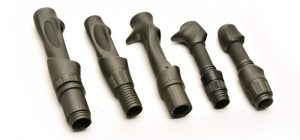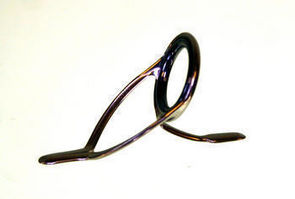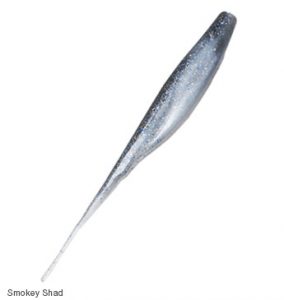When it comes time to pick out a rod it can be down right bewildering. They come in all different sizes, strengths, style, and colors! How do you know which one is the right one for you? The right rod will not automatically make you a better angler but the wrong rod will limit any angler’s ability to catch fish. You should consider your rod as a tool, and as many of us have found out when trying to fix something, having the right tool can make all the difference in the world. There are several factors I want to touch on today that will help you make the right choice for the type of fishing you want to do.
The most obvious question is what species of fish am I targeting? However, this doesn’t do you any good if you do not understand the available features in the different rods. I am going to exclude going into the specifics of reels and fly rods for this article. I want instead to focus on the elements of a fishing rod and their effect on the rod’s ability to do its designed job
Photo: St Croix Rods
The first thing you are going to notice when you pick up a rod is the handle. Is it made of cork or foam? These two products make up a large majority of the types of handles on the market today and each of them have their pros and cons. The cork has long been a traditional handle product. It is a light weight material and feels comfortable on the hand. More importantly it translate vibrations from the rod to the hand better than synthetic materials. This means that you are more likely to feel some of the subtle differences as your bait is moving through the water which makes it a popular choice for throwing soft plastics and finesse fishing tactics. It also doesn’t compress as much under load. Cork will also provide a better grip when it is wet when compared to foam.
One down side is that since cork comes from a tree that is already widely harvested to top wine bottles it is more expensive. Another downside to cork is that it will not last as long as a synthetic material; over time cork can dry out and crack. The durability of this handle does not make it as suitable to fish in vertical rod holders or for bigger game.
Photo: St Croix Rods
The foam handle on the other hand will last you a long time. Since they do not transmit vibration as easily as cork they are better suited for throwing bigger power baits (I.E. crank baits, spinnerbaits, topwater, etc.) and bait fishing for larger fish. When we talk about fighting larger fish, foam’s ability to compress and provide cushion can be crucial. If your hands are cramping then you are going to lose a large portion of your bodies ability to transfer work down into the rod. Another benefit of foam is that it is tougher than cork. That means that it does better in rod holders and in trolling situations where pressure is applied to the handle by the edge of the rod holder. The foam will hold its shape longer and is much less likely to crack or chip.
Since this is only a 101 I do not want to get into the different styles and lengths of handles.
The next component is the reel seat. This is where you are going to place the reel. The reel seat if normally made out of either a light weight polymer or graphite but in some cheaper rods they can be made out of metal. This can be a major issue especially for saltwater fisherman like myself. The salt can cause the seats to rust and make it impossible to put the reel on or take it off the rod.

Photo: Fuji Tackle
It’s important to highlight the importance of a rod’s weight because a lighter rod translates to less strain on your body during a long day of fishing. The reel seat should be ergonomically molded to reduce fatigue and should be contoured to comfortably fit your palm when you hold it. You want your hand to slide in place whether you are casting, fighting, or simply holding the rod waiting for the next bite.
Another component of the reel seat that you need to understand is whether it was designed for a casting or spinning reel. They can very easily be distinguished by either the presence of a trigger: they are for casting reels and spinning reels do not have them. In the case of larger offshore, jigging, and surf rods this more than likely will not be the case. You will need to take a closer look at the description on the rod or the size of the guides. On a spinning rod the guides have to be larger at least for the first couple of eyes because the line does not come off the reel in a linear motion. Instead it loops off in coils. If the eyes are too small they will wrap themselves over the eye causing a range of issue including possible line breakage or equipment failure.

Photo: Fuji Tackle
The guides are the second most important component of the rod. They are literally your contact point between your lure and hand. Most of the guides out there today are made of some form of metal guide with a smooth ceramic ring that allows the line to flow with less friction. The less friction you have the longer you are going to be able to cast and the less heat that will be created as the line travels across. The last thing you want is your line to chafe or heat up causing it to fail. The type of metal used can vary greatly but when it comes down to it you often pay for what you get. Cheaper metal guides are going to be more rigid and heavier and may rust in saltwater while higher end guides are going to be lighter, more conductive, and in the case of titanium, flexible. For those of us that have bent guides or broken them before know how much of a life saver that can be.
The number of guides is also something to consider. Until a certain point, more guides means the rod will cast smoother and transfer feel better than the same rod with less guides. They will also allow the rod to bend more consistently through out the length of the rod which it turn creates a more even distribution of power for longer casts and putting the pressure on the fish.
The most important component in the rod in the material that the blank is made from. A blank is the unfinished rod before adding any of the above mentioned components. Rods are most commonly made from graphite, fiberglass, or a combination of the two. These light weight materials when layered together with resins can create endless combinations of strength and flexibility. Graphite rods are often explained in terms of modulus. Modulus is not a thread count as I have heard it explained by some, but more correctly refers to the stiffness. The higher the modulus, the stiffer the material is by weight, meaning less material is needed to achieve the same stiffness of lower-modulus materials. Basically, the higher the modulus the lighter the rod will be. The higher modulus rods will also be more sensitive and transfer energy more efficiently.
Fiberglass rods tend to be heavier and less sensitive than graphite. This doesn’t mean that fiberglass doesn’t have a place in the fishing world. There are some that claim because fiberglass is less sensitive it prevents them from setting the hook to soon. To those people I say “learn some patience.” If you know that you are in a situation where the fish needs longer to eat or you have missed a couple of fish because of an early hook set just wait a little longer. There is also the belief that because graphite has a tendency to be more brittle than the softer fiberglass is better suited to fighting large game and trolling. It is during these heavy load situations that its believed that fiberglass’s flexibility make it the ideal choice. I don’t know enlist with those minded individuals. I believe that
Photo: U.S. Air Force Staff Sgt. Joshua L. DeMotts
with today’s resins and building techniques that graphite is equally suited in all but the most extreme cases. I will admit that when it comes to using a rod made of a combination of fiberglass and graphite as a stationary bait rod that it will get the job done.
The type of material and its thickness will determine the power and action of a rod. The power is a term that describes the rods lifting ability. The thicker the rod is the heavier the power is going to be. Power is explained by the description of light, med, heavy, etc. When someone talks about the “backbone of a rod” there are referring to the rod’s power. The action of a rod is explained as the rod’s resistance to be bent when pressure is applied . For example a fast action rod will bend from about the the top to about a third of the way down. A moderate action rod will bend down to about the halfway point and a slow action rod will almost completely double over.
That being said what does that mean to you? The fast action is best used in situations where you want quick and sharp movements applied to your lure. A moderate action rod is going to translate less of the immediate energy when working a bait. This has its benefits for fishing slower techniques and for fishing baits with treble hooks like crank baits or top water. The extra give that this rod has allows for a lesser chance of ripping the hooks out of the fishes mouth. The slow action is often used for fishing light lures where power is not needed and for casting longer distances.
The action’s ability to transfer the load directly affects the accuracy and casting distance. The faster tip results in a more accurate the rod because this action returns faster to its resting position. The same feature that promotes accuracy does not help when it comes to distance. The softer rod in this case allow for a better load and transfer of power in turn resulting in longer but less accurate casts. The casting distance is also directly effected by the by the length of the rod, the longer the rod the further you can throw it. This is a major benefit when trying to get near spooky fish or fishing from the surf.
Rod lengths vary depending on the situation and the species. While a long rod is more accurate, this is less powerful than a shorter counterpart. When fishing with longer rods I tend to use them in open areas or in situations where I need the height of the rod to keep me above obstructions such as tall grass. When fishing in situations that require me to put the pressure on the fish quickly to get them out of cover or my casting is obstructed I prefer a short length rod. The shorter length allows me to apply more pressure vs the longer more flexible version.
Now that you have a better understanding of how rod design relates to the capabilities, you should be ready to purchase your next rod confidently.

